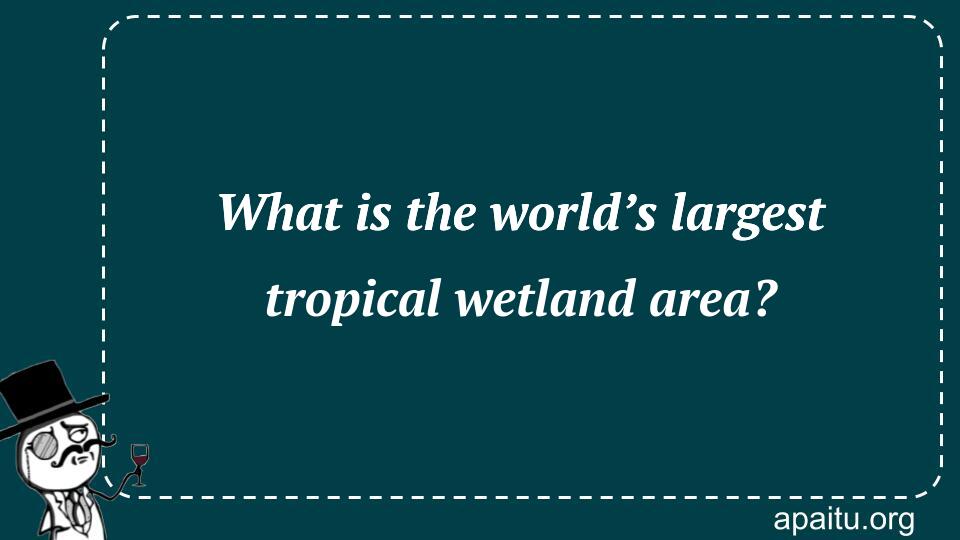Question
Here is the question : WHAT IS THE WORLD’S LARGEST TROPICAL WETLAND AREA?
Option
Here is the option for the question :
- The Camargue, France
- The Mekong Delta, Vietnam
- The Pantanal, Brazil
- The Everglades, United States
The Answer:
And, the answer for the the question is :
Explanation:
The Pantanal region spans more than 70,000 square miles over three countries: Brazil, Bolivia, and Paraguay, and includes both national park property and UNESCO World Heritage Sites. Every year, the huge Patanal basin fills with severe rains and slowly drains into the Paraguay River. The region is home to the most fauna in South America.

The Pantanal, located in Brazil, is widely recognized as the world’s largest tropical wetland area. This vast and biodiverse region, encompassing an estimated 150,000 to 195,000 square kilometers (58,000 to 75,000 square miles), is a natural wonder teeming with unique ecosystems, abundant wildlife, and breathtaking landscapes. In this article, we delve into the wonders of the Pantanal, exploring its ecological significance, rich biodiversity, and the conservation efforts aimed at preserving this remarkable wetland.
Situated primarily in the Brazilian states of Mato Grosso and Mato Grosso do Sul, the Pantanal spans across a vast expanse of low-lying plains, encompassing a mosaic of habitats including marshes, lagoons, rivers, and seasonal floodplains. It is characterized by a distinctive seasonal climate, with a wet season from November to March, when heavy rainfall causes the region’s rivers to overflow and flood the surrounding areas. This annual flooding creates a dynamic and ever-changing landscape that supports a rich array of plant and animal life.
The Pantanal’s ecological significance is unparalleled. Its wetlands act as natural filters, purifying water and providing essential ecosystem services. The region plays a crucial role in regulating water flow, mitigating floods, and maintaining water quality in the surrounding areas. The wetland’s ability to retain and slowly release water helps recharge groundwater reserves and contributes to the overall health of the region’s hydrological systems.
One of the defining features of the Pantanal is its extraordinary biodiversity. The wetland is home to an astonishing variety of flora and fauna, including numerous endemic and endangered species. It is estimated that the Pantanal harbors over 4,700 plant species, 1,200 bird species, 325 fish species, and 159 mammal species. Among its iconic residents are jaguars, giant anteaters, tapirs, capybaras, marsh deer, and the majestic Hyacinth macaw, the world’s largest flying parrot. The wetland also supports a remarkable diversity of reptiles, amphibians, and aquatic species, making it a true haven for wildlife enthusiasts and researchers alike.
The Pantanal’s rich biodiversity is closely linked to its diverse habitats. The region’s mosaic of wetlands, forests, savannas, and gallery forests creates a patchwork of niches that support a wide range of specialized species. The wetland’s seasonal flooding patterns provide essential breeding grounds and feeding areas for migratory birds, attracting thousands of individuals from different parts of the world. The Pantanal’s marshes and lagoons are also a haven for fish, providing abundant food sources for predatory species such as caimans and giant river otters.
Recognizing the ecological importance and vulnerability of the Pantanal, conservation efforts have been underway to protect this unique wetland. Environmental organizations, governmental agencies, and local communities are working together to establish protected areas, promote sustainable tourism practices, and raise awareness about the need for conservation. These initiatives aim to balance the economic development of the region with the preservation of its natural heritage, ensuring the long-term sustainability of the Pantanal’s ecosystems.
However, the Pantanal faces several challenges that put its delicate ecosystem at risk. Climate change, deforestation, wildfires, and unsustainable agricultural practices pose significant threats to the wetland’s integrity. The region has experienced devastating wildfires in recent years, exacerbating the loss of habitat and endangering wildlife populations. Efforts to combat these challenges include fire prevention and management strategies, reforestation projects, and the promotion of sustainable land use practices.
the Pantanal in Brazil stands as the world’s largest tropical wetland area, offering a breathtaking display of nature’s wonders. Its ecological significance, rich biodiversity, and stunning landscapes make it a globally recognized treasure. As conservation efforts continue to safeguard this unique wetland, it is our collective responsibility to support sustainable practices and raise awareness about the importance of preserving the Pantanal for future generations to appreciate and cherish.